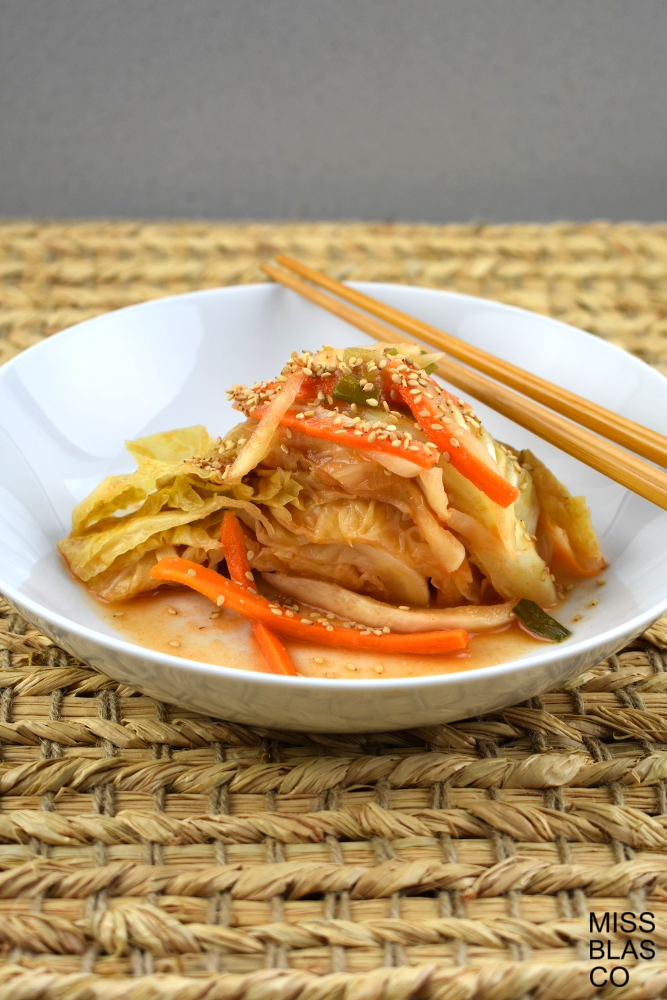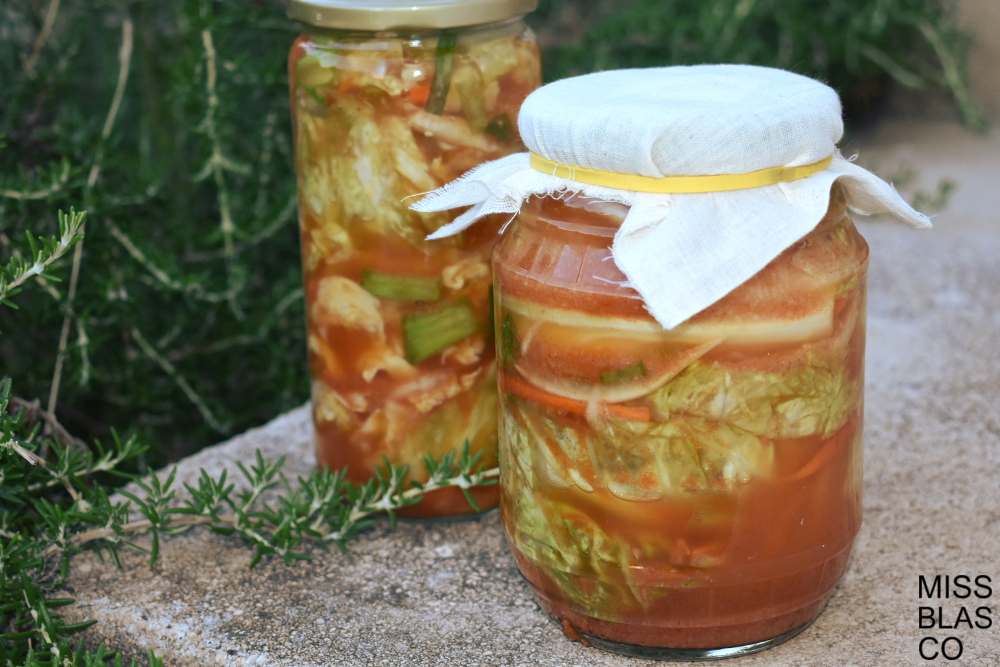
HOW TO MAKE EASY KIMCHI (RECIPE)
In this post I want to show you how to make an easy kimchi, without overcomplicating things, with easy-to-find ingredients.
Kimchi is the most famous and international Korean dish. You can eat kimchi in practically any city in the world. It has a strong, spicy flavor and is usually served as a side dish to accompany other dishes.
Making kimchi at home is relatively simple. It involves marinating cabbage along with other vegetables in a paste that contains garlic, ginger, cayenne pepper, spring onion, and rice grits.
Kimchi is fermented cabbage, with a salty, spicy, and very tasty paste.
The cabbage is left a few hours in brine to soften and release water, then rinse and mix with the spicy paste, store in a container at room temperature for 48 hours, so that it does its initial fermentation.
The ideal temperature for the process to start is between 18 and 20ºC, if it is warmer perhaps 24 hours of fermentation at room temperature will be enough.
After two days, you will see that when you press the cabbage in the fermentation liquid, little bubbles come out, congratulations! the process has started successfully, now you can store it in the refrigerator to continue fermenting.

What is lactic fermentation?
Vegetables that are preserved in a salty medium undergo a process of lactic fermentation. Said fermentation occurs in the cytoplasm of the cell and consists of the degradation of glucose to obtain metabolic energy and the production of lactic acid.
When kimchi ferments, its organoleptic characteristics change and its flavor improves.
To make it easier for you to understand, fermentation breaks down the monosaccharides, disaccharides, oligosaccharides, and polysaccharides (starches) in food into lactic acid.
It breaks down the glucose, fructose, and galactose (what we know as sugars) in food into lactic acid.
Lactic acid stops any decomposition process (the appearance of harmful microorganisms), which is why food is preserved for long periods of time. This is because it lowers the pH of the medium, acidifying it.
This entire process occurs in an anaerobic environment, that is, without oxygen, which is why the food must be submerged in the maceration liquid at all times.
The bacteria responsible for this process are called lactic acid bacteria.
In the specific case of kimchi, almost 20 years ago, the bacteria that, together with other lactic acid bacteria (Streptococcus, Weissella and some species of Lactobacillus), is responsible for giving it the organoleptic characteristics it has was isolated. This is Lactobacillus kimchii.
It is the most famous dish in Korea and there are many different recipes, I propose this easy kimchi.
As you can imagine, kimchi being the most famous dish in Korea, there are hundreds of recipes and they vary depending on the region. In the north, a more “watery” kimchi is made, with less salt and less cayenne, without seafood.
On the other hand, in the south of the country, kimchi is prepared with a thicker, spicier sauce and also usually includes brined seafood or fermented anchovies and their juice.
Whichever way you prefer, I encourage you to try it, my recipe is very simple, with ingredients that you have at your fingertips.
A good idea is to spend the weekend preparing it calmly, and then store it for weeks or months to consume it little by little little.

What I like most is seeing how the nuances of its flavor change as the days go by.
It is important that you taste the paste when you are making it to calibrate the level of spiciness, but don’t be scared if it seems too strong at first.
When it ferments, as the bacteria do their work, the flavor will change, new nuances, and it will be much richer.
Kimchi provides live microorganisms that improve the intestinal microbiota.
BeneficBenefits of kimchi:
Being a fermented food, kimchi has several benefits, primarily the contribution of live microorganisms that contribute to improving our intestinal microbiota.
It is considered a suitable food in the treatment of inflammatory diseases and the power of Lactobacillus to combat fungal infections such as Candida has been studied.
- It provides lactic acid.
- It contains vitamins C, A, B1 and B2.
- It is a source of carotenes.
- It provides few calories and is rich in water.
Its high salt content is also notable, as it is the result of a lactic fermentation process in a salty medium. Make sure to wash the cabbage well afterwards. of the first step, this way you will have better control over this point.
How to consume kimchi:
- Just serve yourself a portion and enjoy it.
- Accompanied by quinoa or any other whole grain of your choice (rice, for example).
- Adding a portion to tofu soup, or accompanied by marinated and sautéed tofu.
- With noodle soup.
Why I like this recipe so much:
- Because, like all fermented foods, it is a live food that provides a wide variety of microorganisms.
- Because I can control the ingredients and the fermentation times, obtaining different results.
- It adds different flavors and textures to my dishes.
- It keeps for a long time in the refrigerator, it can be kept for months.
- It can be consumed alone or with other foods, and it can also be added to soups and broths.
Related posts:
If you want more information, I leave you some interesting links:

KIMCHI FÁCIL
Ingredients
Para la base
- 700 g col china (akusay) (1 unidad) Si no la encuentras, usa una col rizada o un repollo liso.
- 1 taza sal marina gruesa (puede que no la uses toda)
- 150 g nabo blanco (1 unidad grande)
- 125 g zanahoria (2 unidades)
- 100 g cebolleta La parte verde, los tallos
Para la pasta
- 1/2 cda cayena molida (si no tienes cayena molida, añade entre 4 y 6 guindillas secas)
- 1/2 cda pimentón picante (el toque spanish, totalmente opcional)
- 4 cda salsa de soja (en la receta original se suele usar salsa de pescado coreana, pero si quieres una receta vegana, usa la de soja)
- 1/2 taza arroz blanco cocido
- 3 taza agua de cocción del arroz (cuece el arroz con agua salada, en la receta original de usa sémola de arroz)
- 50 g ajo (3 dientes de ajo)
- 50 g cebolleta (1 unidad)
- 50 g jengibre fresco
Instructions
- Lo primero que debes hacer es lavar la col y cortarla en cuartos, si es muy grande, corta cada cuarto por la mitad, en sentido longitudinal. De esta manera, cuando el kimchi esté hecho, tendrás trozos grandes de col que podrás cortar como quieras para consumirlos.

- Reparte la sal gruesa por toda la col, embadurna por fuera y pon sal entre las hojas, separa las hojas con cuidado y ve poniendo sal.Deja macerar la col con la sal durante unas 5-6 horas a temperatura ambiente.

- Pasado ese tiempo la col habrá perdido agua y se habrá reblandecido, es hora de enjuagarla para eliminar el exceso de sal.
- Ahora es el momento de cortar el resto de verduras, cuanto más finas mejor, también puedes rallarlas.

- Cuece el arroz redondo blanco en agua con sal durante 20 minutos, aproximadamente, y reserva.
- Por otro lado hacemos la pasta para el kimchi. En un robot de cocina añadimos los ajos, el jengibre fresco, la cebolleta, la cayena, el pimentón (opcional), la salsa de soja, el arroz cocido y el agua de cocción del arroz. Tritura bien.

- El siguiente paso es mezclar las verduras cortadas en juliana o ralladas con la pasta que acabamos de hacer y embadurnar la col. Hazlo con las manos y asegúrate de repartir la mezcla entre las hojas de la col.

- La idea es que la col quede sumergida en líquido, por eso si ves que con la pasta que has hecho no es suficiente, haz más. Esto dependerá del tamaño de la col que uses.
- Pon la col bien embadurnada en la salsa dentro de botes de vidrio, o en un recipiente plano, preferiblemente de vidrio, tápalo y deja fermentar durante 48 horas a temperatura ambiente. Si es verano y hace mucho calor, con 24 horas puede ser suficiente, ve mirando cómo va, si al apretar la col dentro del líquido salen burbujas, ya está empezando a fermentar.

- Después de este primer paso, guarda el kimchi en el frigorífico, trata de que esté bien sumergido en el líquido, lo más fácil es conservarlo en botes de vidrio, poner una hoja de col en la capa superior y añadir algún elemento que ejerza presión, por ejemplo un trozo de nabo grande o un trozo de zanahoria. Si tienes recipientes especiales para fermentar, no necesitas hacer ningún truco de estos.

- Una vez tengas el kimchi en el frigorífico, el proceso de fermentación continuará, pero más lentamente, puedes conservarlo durante mucho tiempo, y observarás que a medida que pasan los días el sabor irá variando, las bacterias trabajan y van cambiando las características organolépticas de la mezcla.

Natalia
Al ser un alimento fermentado y cambiar su composición, pierde parte de sus propiedades internas y descomponer la fructosa , galactosa y glucosa, mi pregunta es, ¿las personas con malabsorción de la fructosa e intolerancia a la lactosa, podrían tomarla como un buen alimento?
missblasco
Cuando hay intolerancia a la lactosa y además malabsorción de fructosa, los protocolos dietéticos a seguir son complejos, dependiendo del grado de afectación, se puede pautar una dieta baja en FODMAP por parte de un especialista que controlará las diferentes fases del proceso. Los vegetales al fermentar cambian sus propiedades, pero eso no significa que sean aptos necesariamente en todos los casos, así que no puedo afirmar que el kimchi sea adecuado para ti. Saludos!
Patricia Perez
Tiene muy buena pinta, pero tiene mucha cantidad de sal según veo en la tabla nutricional que añades. Esto seria un aspecto bastante negativo de este alimento.
missblasco
Hola Patricia, la sal tiene una función, se utiliza para frotar la col con ella y dejarla “sudar”, cuando ya ha perdido agua, se enjuaga para eliminar ese exceso de sal (paso 3 de la receta).
Saludos cordiales.